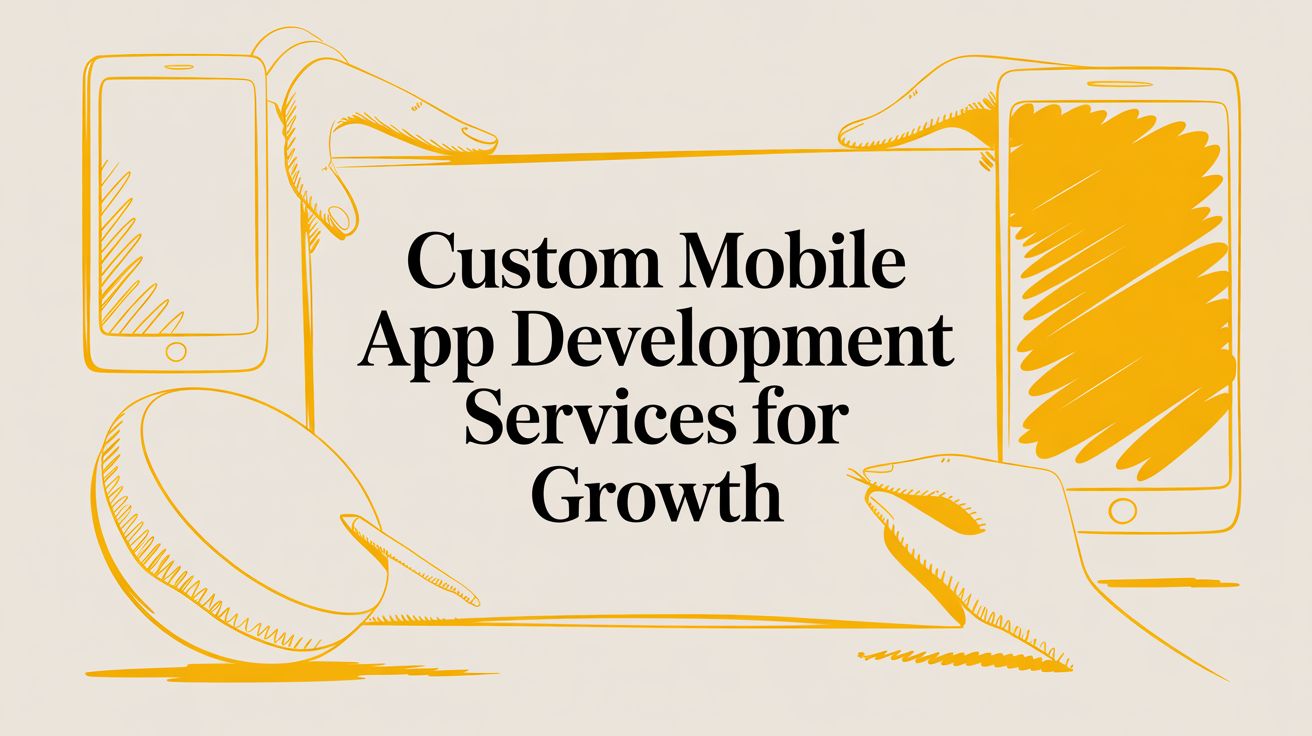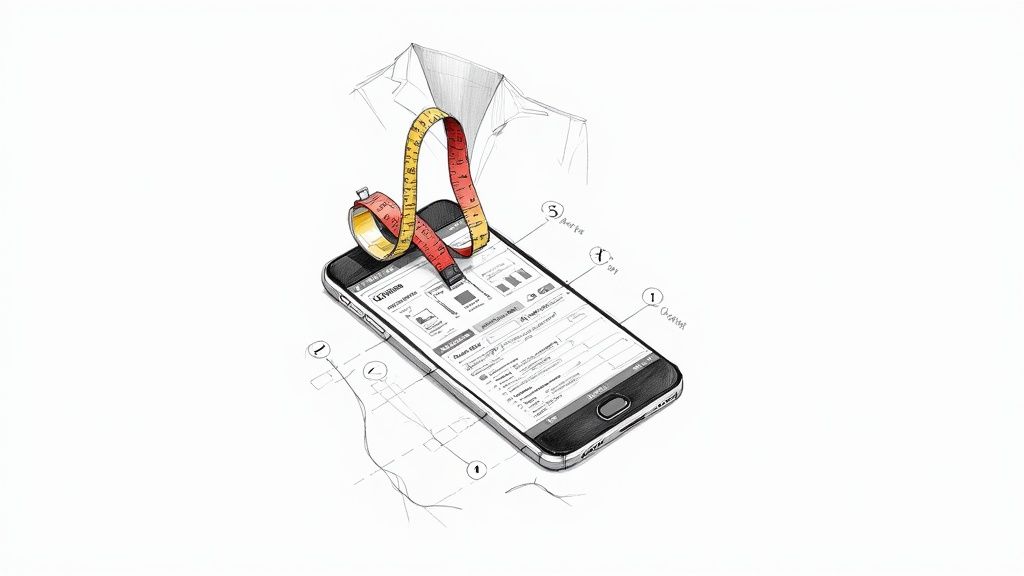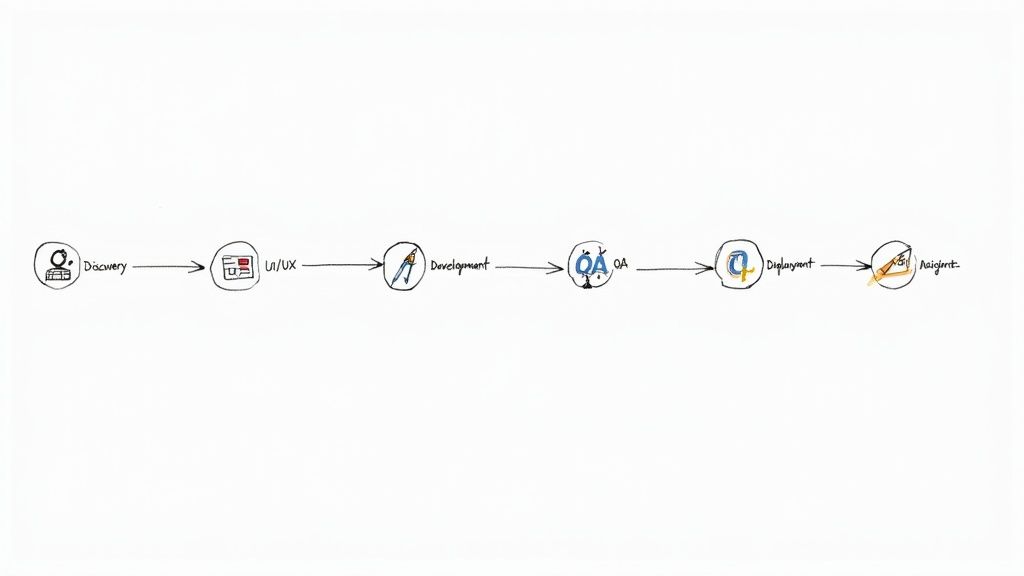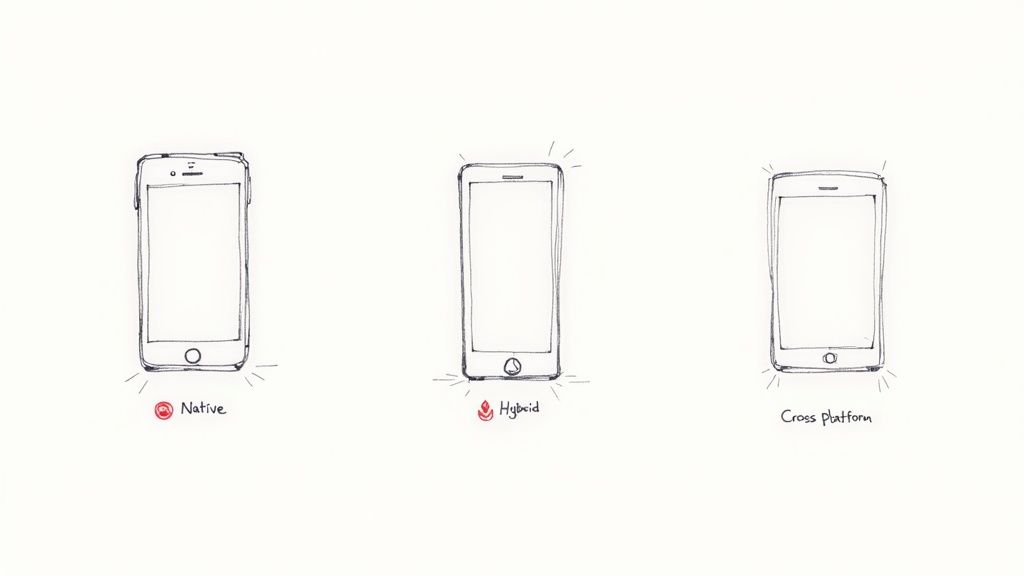Custom Mobile App Development Services for Growth

When you hear the term custom mobile app development services, it's easy to just think of coders typing away in a dark room. But it's so much more than that. It's the entire process of building a unique software application from the ground up, designed specifically for your business, your processes, and your customers.
This isn't about grabbing a one-size-fits-all solution off the shelf. It’s a complete journey from a rough idea to a polished, high-performing digital tool that includes strategy, design, coding, testing, and continuous support.
What Are Custom Mobile App Development Services

Here’s a simple way to think about it. Off-the-shelf software is like buying a rental tuxedo. Sure, it gets the job done for a basic event, but it was made for the average person and probably doesn't fit you perfectly. Custom app development, on the other hand, is like getting a bespoke suit. It’s measured and cut precisely for your business's unique shape, style, and goals.
This made-to-order approach is why the demand for custom solutions is exploding. The global market for custom software, which mobile apps are a huge part of, was valued at around USD 44.52 billion in 2024. It’s expected to jump to USD 53.95 billion in 2025. This growth is being fueled by businesses wanting to integrate powerful tools like AI and IoT to create a real edge. You can see more details on this market trend over at Codewave.com.
Beyond Just Coding
A common misconception is that development is just about writing code. In reality, that’s only one piece of the puzzle. A true custom development service is an end-to-end partnership that turns a concept into a real, market-ready product. The process involves several key stages, and skipping any of them can lead to a failed app.
A great development partner will walk you through everything:
- Strategy and Discovery: This is where it all begins. They help you define clear business goals, pinpoint your target audience, and map out the app's essential purpose and features.
- UI/UX Design: Long before any code is written, designers create intuitive wireframes, user flows, and beautiful mockups. The goal is to make the app effortless and enjoyable to use.
- Development and Engineering: Here’s the "building" phase. Developers construct the frontend (what you see and interact with) and the backend (the engine, servers, and databases) using the right technology for the job.
- Quality Assurance (QA) Testing: This is a crucial step. Testers rigorously try to "break" the app to find and squash bugs, ensuring it's stable, secure, and works perfectly on all kinds of devices.
The whole point is to build a digital tool that fits your internal workflows like a glove, solves problems specific to your industry, and connects with your audience in a way no generic app ever could. This is where you gain a true competitive advantage.
The Final Stages of the Process
Once all the hard work of building and testing is done, the app is ready for the world. The deployment stage involves carefully submitting the application to the Apple App Store and Google Play Store, making sure it passes all of their strict publishing guidelines.
But a good partner doesn't disappear after launch day. Top-tier custom mobile app development services always include post-launch support and maintenance. This final, ongoing phase is what keeps your app secure, updated for new operating systems, and capable of scaling up as your business and user base grow.
Why a Custom Mobile App Is a Business Game-Changer
When you're serious about growth, generic tools just don't cut it. Investing in a custom-built app isn't just about getting a unique icon on the App Store; it's a strategic move that pays off in scalability, security, and the kind of customer loyalty that off-the-shelf software can't buy.
Think of it like this: an off-the-shelf app is a rental tuxedo. It fits okay, does the job for a night, but it's not yours. A custom app is a bespoke suit, measured and cut to fit your business perfectly, from the way you handle inventory to the specific way you talk to your customers.
This tailored approach is fueling incredible market growth. In 2024, the U.S. mobile app market hit a staggering USD 197.3 billion. Looking ahead, the global market is on track to jump from USD 265 billion in 2025 to over USD 543 billion by 2030. That's not just a trend; it's a massive shift toward unique digital experiences. You can explore more insights into these market projections on GrootSoftwares.com.
Build for Tomorrow, Not Just Today
Sooner or later, every growing business hits the limitations of generic software. You hit a wall where you can't add a crucial feature, forcing you into clumsy workarounds or a painful migration to another system. Custom apps are built to grow with you from day one.
As your business evolves—adding new product lines, expanding into new regions, or onboarding thousands of new users—your app can adapt right alongside you. You're investing in a long-term asset, not a temporary fix that will need replacing.
- Scalable Architecture: A custom backend can be engineered to support 10,000 users today and 10 million tomorrow without needing a complete teardown.
- Flexible Feature Integration: Since you own the code, adding a new payment gateway or a sophisticated AI recommendation engine is a planned update, not an impossible request.
This forward-thinking design saves you from the massive headaches and costs that come from outgrowing your technology. It ensures your app remains a powerful engine for growth, not a roadblock.
A custom app is an asset that appreciates in value as your business grows. It adapts to your needs, integrates new technologies, and scales alongside your success, ensuring you never have to start from scratch again.
Fortify Your Digital Walls
In a world where data breaches are front-page news, relying on the same software as thousands of other businesses is a gamble. When a vulnerability is found in a popular platform, every company using it becomes an instant target. Custom apps give you a much stronger defensive line.
Security isn't just a feature you bolt on at the end; it's woven into the app's DNA from the first line of code. This allows you to build for your specific security needs and meet strict industry compliance rules, whether it's HIPAA in healthcare or PCI DSS for financial transactions.
Achieve Flawless Operational Harmony
Let's be honest, your business probably runs on a whole cocktail of different tools—a CRM for customer data, an ERP for inventory, and so on. Trying to make off-the-shelf apps talk to these systems can feel like a nightmare of mismatched software and endless manual data entry.
This is where custom APIs (Application Programming Interfaces) save the day. They act as perfect, seamless translators between your new app and your existing software, creating a single, automated workflow.
Here’s how it works in the real world:
- A customer places an order on your custom mobile app.
- The API instantly tells your ERP system, which updates inventory levels automatically.
- At the same time, the customer's purchase history is logged in your CRM, giving your sales team a complete, up-to-the-minute view.
This level of deep integration breaks down data silos, slashes human error, and frees your team from soul-crushing admin work. The result is a smarter, faster, and more profitable business run on a digital ecosystem that truly works together.
Your Guide to the App Development Lifecycle

Turning a brilliant idea into a functional app on someone's phone can seem like a monumental task. But it’s not magic—it's a well-defined process. The custom mobile app development lifecycle is a proven roadmap that takes a project from a simple concept to a polished, market-ready product and keeps it running smoothly.
Think of it like building a custom home. You wouldn't just start laying bricks without a detailed blueprint, an architect, and a solid plan for the plumbing and electrical systems. Each phase of the app lifecycle serves a critical purpose, making sure the final product is stable, user-friendly, and built to last. For a deeper look at the nitty-gritty, you can explore our detailed guide on the mobile app development lifecycle.
This methodical approach is what makes building powerful, custom applications possible. And it’s a booming field—the global number of software developers is projected to hit 28.7 million by 2025, a jump of 4.2 million since 2020, as the demand for smarter apps continues to grow.
Phase 1: Discovery and Strategy
This is where every great app gets its start. Before a single line of code is written, you have to dig deep into the "why" behind the project. It’s the critical intersection of your business goals and the reality of the market.
During discovery, the development team works hand-in-hand with you to nail down clear objectives, pinpoint your target audience, and scope out the competition. This phase is all about asking the tough questions upfront to prevent costly missteps down the road.
Key activities typically include:
- Defining Goals: What specific problem will this app solve for your business or customers?
- Audience Research: Who are you building this for, and what do they truly need?
- Competitor Analysis: What are others in your space doing well, and where are the opportunities they've missed?
- Feature Prioritization: What are the absolute must-have features for a Minimum Viable Product (MVP)?
The goal here is a crystal-clear project brief and a strategic roadmap that aligns everyone on the vision and guides the entire process.
Phase 2: UI and UX Design
With a solid strategy locked in, the focus shifts to how the app will actually look, feel, and function. While often mentioned together, User Interface (UI) and User Experience (UX) design are two distinct disciplines. UX is the invisible architecture—the logic and flow—while UI is the visual skin and interactive elements laid on top.
First, UX designers create wireframes, which are like simple, black-and-white blueprints of the app's screens and user journeys. This lets everyone focus purely on functionality and navigation without getting distracted by colors or fonts. Once that flow feels right, the UI designers take over, creating high-fidelity mockups and interactive prototypes that bring the app's visual identity to life.
Great design isn't just about making things pretty; it's about creating an intuitive, seamless experience that solves a user's problem without them having to think too hard.
Phase 3: Development and Coding
Now for the part most people picture when they think of app creation: the actual build. Guided by the designs and the strategic roadmap, developers get to work writing the code that will power the app. This stage is usually split into two key parts:
- Frontend Development: This is everything the user sees and touches—the buttons, screens, and menus. It’s the "client-side" of the application.
- Backend Development: This is the server-side engine running behind the scenes. It handles the database, server logic, and APIs that manage data, user accounts, and all the other heavy lifting.
The technology stack—the specific programming languages, frameworks, and tools—is chosen based on the project's needs, whether it's a native iOS app, an Android app, or something that works across both platforms. If you're new to this world, understanding how to create your own app can give you some great context for this entire lifecycle.
Phase 4: Testing and Quality Assurance
Let's be real: no app is perfect on the first try. The Quality Assurance (QA) phase is an absolutely essential step designed to hunt down and squash bugs, glitches, and performance hiccups before your users ever see them.
QA testers put the application through its paces with a whole battery of tests to ensure it meets the highest standards.
Common Types of Testing:
- Functional Testing: Does every single feature work exactly as it's supposed to?
- Usability Testing: Is the app intuitive and easy for a real person to navigate?
- Performance Testing: How is the app's speed, responsiveness, and battery usage?
- Security Testing: Are there any vulnerabilities that could put user data at risk?
This meticulous process is what ensures the final product is stable, secure, and delivers a smooth experience right from the first download.
Phase 5: Deployment and Maintenance
After passing every QA check with flying colors, the app is finally ready for its debut. The deployment process involves packaging the app and formally submitting it to the Apple App Store and Google Play Store, making sure to follow all of their specific rules and guidelines.
But launching the app isn't the finish line. Ongoing maintenance is what separates a flash in the pan from a long-term success. This means providing regular updates to support new operating systems, fixing any bugs that pop up after launch, monitoring performance, and rolling out new features to keep the app fresh, relevant, and competitive.
To help you visualize this entire journey, here’s a quick breakdown of each phase.
Custom App Development Phases at a Glance
The table below summarizes the core activities and outcomes for each step in the custom app development lifecycle.
| Phase | Key Activities | Primary Outcome |
|---|---|---|
| 1. Discovery & Strategy | Market research, competitor analysis, goal setting, feature prioritization. | A detailed project roadmap and a clear Minimum Viable Product (MVP) scope. |
| 2. UI/UX Design | Creating wireframes, mockups, and interactive prototypes. | A user-friendly and visually appealing design that is ready for development. |
| 3. Development & Coding | Writing frontend and backend code, building the app architecture. | A functional, coded application that brings the design to life. |
| 4. Testing & QA | Functional, usability, performance, and security testing. | A stable, bug-free, and secure app ready for public release. |
| 5. Deployment & Maintenance | App store submission, server setup, ongoing updates, and bug fixes. | A live app available to users, with a plan for long-term support. |
This structured lifecycle ensures that every aspect of the app is carefully considered, from the initial idea to its ongoing success in the market.
Choosing the Right Development Approach

One of the first, and most critical, decisions you'll make is which technology to build your app with. This choice ripples through everything—your budget, timeline, and ultimately, how your app performs in the hands of your users. Think of it like choosing the foundation for a new house; get it right, and everything else is built on solid ground.
You'll hear about three main paths: Native, Hybrid, and Cross-Platform. Each has its own distinct pros and cons, and understanding them is key to making sure your tech stack aligns with your business goals.
Native Development: The Performance Benchmark
When you need uncompromising performance and a flawless user experience, native development is the way to go. This means building two entirely separate apps from scratch: one for Apple's iOS (using Swift or Objective-C) and another for Google's Android (using Kotlin or Java).
It’s like commissioning a tailor to make two bespoke suits, one for a winter climate and one for summer. Each is perfectly crafted for its specific environment using the best possible materials, resulting in an impeccable fit and feel.
Native apps are incredibly fast, responsive, and can tap directly into all of the device’s hardware, like the camera, GPS, and biometric scanners. This is the undisputed champion for demanding applications like high-end games, photo editing software, or anything requiring heavy processing.
Hybrid Development: A Web-Powered Solution
Hybrid development works differently. It takes existing web technologies—HTML, CSS, and JavaScript—and wraps a single web application inside a simple native "shell." This allows it to be downloaded from app stores just like any other app.
This approach is a bit like a "one-size-fits-all" t-shirt. It gets the job done and is very cost-effective, but it won't have the tailored fit or premium feel of a custom-made garment.
While hybrid apps are faster and cheaper to produce, that efficiency often comes at the cost of performance. They can feel a little sluggish and may not feel perfectly integrated with the device. This makes them a solid choice for simpler, content-focused apps, such as company directories or basic event guides.
Cross-Platform Development: The Best of Both Worlds
Cross-platform development has emerged as a powerful middle ground, offering a fantastic balance of efficiency and quality. Using frameworks like React Native or Flutter, developers write a single codebase that gets compiled into near-native apps for both iOS and Android.
This is like using a master architectural blueprint that can be slightly adapted to build two incredible, nearly identical houses on different lots. You maintain quality and consistency without having to design everything twice from the ground up. If you want to dive deeper, you can find a great overview here: https://getnerdify.com/blog/mobile-app-cross-platform-development.
The performance is so close to native that for most apps, users will never notice the difference. Plus, you get the huge advantage of a unified development cycle. Choosing the right React Native libraries, for example, can further accelerate development while adding powerful functionality.
Cross-platform development often hits the sweet spot for businesses. It allows for 70-90% code reusability between platforms while delivering performance that feels native for the vast majority of apps.
This approach dramatically cuts down on development time and costs, all while delivering a fantastic user experience. It's become a go-to choice for businesses that need to be smart with their resources but aren't willing to compromise on quality.
So, how do you pick the right one for you? Let's put them side-by-side.
Comparison of Mobile App Development Platforms
Making the right choice really boils down to your specific project needs and priorities. This table breaks down the key trade-offs between each approach.
| Feature | Native App | Hybrid App | Cross-Platform App |
|---|---|---|---|
| Performance | Highest possible speed and responsiveness. | Moderate performance; can feel less smooth. | High, near-native performance. |
| Development Cost | Highest cost due to separate codebases. | Lowest cost due to a single web codebase. | Moderate cost; more affordable than native. |
| Time-to-Market | Longest, as two apps are built separately. | Fastest, as one app is built for all platforms. | Fast, with a single codebase for both stores. |
| User Experience | Best possible; follows platform conventions. | Good, but may lack a true native feel. | Very good; can closely mimic native UI/UX. |
| Access to Features | Full, immediate access to all device APIs. | Limited; relies on plugins for native features. | Excellent access to most native features. |
In the end, there's no single "best" option—only the best option for your app. A great development partner won't just build what you ask for; they'll help you navigate these choices to find the perfect fit, whether it's the raw power of Native, the efficiency of Hybrid, or the balanced approach of Cross-Platform.
How to Find the Right Development Partner

Choosing a partner for your custom mobile app development services is a decision that will make or break your project. It's just as critical as the app idea itself. Your agency isn't just a hired gun; they're the team that will bring your concept to life. The right partner can put you on the fast track to success, while the wrong one often leads to a mess of blown budgets, missed deadlines, and a final product that just doesn't work.
Think of it like hiring a contractor to build your dream home. You wouldn’t just go with the cheapest quote you could find. You’d pour over their portfolio, talk to past clients, and ensure their style and work ethic match what you’re looking for. The same careful vetting process is absolutely essential here.
Look Beyond the Price Tag
It's tempting to immediately compare proposals and drift toward the lowest bid. But in the world of software development, a suspiciously low price can be a huge red flag. It might signal an inexperienced team, sloppy code, or hidden fees that will bite you later on. Instead, your focus should be on getting real value from proven experts.
A potential partner's portfolio is the first place you should look. Do they have a track record of building and launching apps like yours, especially in your industry? An agency that’s built a dozen e-commerce apps will already know the ins and outs of payment gateways and inventory systems. One with a background in health tech will be well-versed in complex regulations like HIPAA compliance.
Evaluate Their Process and Communication
How a company builds things tells you everything about how your project will go. Ask them to walk you through their development process from start to finish. Most solid agencies today use an agile framework, like Scrum, which breaks the project into small, manageable cycles called "sprints."
This method keeps things flexible and allows for constant feedback. It means you can make adjustments along the way without derailing the whole timeline. It’s a truly collaborative approach that keeps you in the loop, not in the dark.
A partner’s communication style is a direct reflection of their project management maturity. Vague updates and infrequent check-ins are signs of trouble. You need a team that offers transparency, clear reporting, and a dedicated point of contact.
It’s also smart to understand how they structure their teams and engagement models. Some businesses thrive with a full-service agency, while others might benefit from a different setup. To get a better handle on this, our guide on staff augmentation vs outsourcing breaks down the pros and cons of different models.
Essential Questions to Ask Potential Partners
To really dig in, you need to ask sharp questions that go beyond the surface-level sales pitch. A good partner will have direct, confident answers. Treat these initial calls like an interview—because that’s exactly what they are. You're hiring a crucial extension of your team.
Here's a checklist of key questions to get the conversation started:
- Project Management: How will our project be managed day-to-day? What tools do you use for communication and tracking progress, like Jira or Slack?
- Team Structure: Who exactly will be on my team? Can I talk to the project manager or lead developer assigned to my app?
- Intellectual Property: Who owns the source code when this is all done? Your contract needs to state clearly that you own 100% of it.
- Security Protocols: What specific steps do you take to secure our app's code and user data, both during and after development?
- Post-Launch Support: What happens after we go live? What does your support and maintenance plan look like, and are there different levels available?
By carefully checking their past work, digging into their workflow, and asking these direct questions, you can find a development partner who not only has the right skills but truly gets your vision. This is the foundation every great custom app is built on.
Your Custom App Development Questions, Answered
Jumping into a custom app project always brings up a few big, practical questions—usually about cost, timelines, and strategy. Getting clear, honest answers is the first step toward making a smart investment. Let's break down some of the most common questions we hear from businesses every day.
How Much Does a Custom Mobile App Cost?
This is always question number one, and the most truthful answer is: "It depends." The cost of building a custom app is tied directly to its complexity. It’s a bit like building a house—a simple one-bedroom cottage and a sprawling mansion with a swimming pool are both houses, but their price tags are worlds apart.
The final number comes down to a few key ingredients that dictate the amount of work required.
- Feature Count: A simple app with five core functions will naturally cost less than an enterprise-grade platform with twenty features, complex algorithms, and multiple third-party integrations.
- Design Complexity: A clean, straightforward user interface is faster to create than one filled with custom animations, detailed graphics, and intricate user flows.
- Platforms: Are you building for just iOS, just Android, or both? A native app for each platform will require more development hours than a single-platform or cross-platform build.
- Backend Infrastructure: How robust does your backend need to be? The complexity of the server, database, and APIs supporting your app is a huge factor in the final cost.
While a simple app might fall into one price bracket, a complex enterprise solution will command a much larger budget. The only way to get a truly accurate quote is to go through a discovery phase and create a detailed project scope.
Pro-tip: Don't forget to budget for what comes after the launch. A successful app needs ongoing investment in server hosting, regular maintenance, bug fixes, and future updates to stay secure and competitive.
How Long Does It Take to Build a Custom App?
Much like the cost, the timeline is all about the scope. Quality takes time, and rushing the development process almost always leads to a clunky user experience and a pile of technical debt you’ll have to fix later.
A typical project breaks down into a few distinct phases. For an app of moderate complexity, a rough timeline might look something like this:
- Discovery and Strategy: This is the foundation. It usually takes 2-4 weeks of deep dives, workshops, and research to get right.
- UI/UX Design: Crafting the user experience with wireframes, mockups, and prototypes can take another 4-8 weeks, depending on how many screens and interactions are involved.
- Development and Testing: This is the longest part of the journey. The actual coding and quality assurance can easily last 12-24 weeks or more.
Remember, these are just estimates. The project's unique needs can shift the timeline. One of the biggest variables is actually you. Providing clear, timely feedback and making decisions quickly at each stage is critical for keeping the project on track.
What Is an MVP and Why Does It Matter?
You’ll hear the acronym MVP—or Minimum Viable Product—in just about any conversation with a development agency. It’s not a buggy or incomplete app. Think of it as the simplest, most focused version of your app that solves one core problem for your very first users. It’s a strategic first step.
Launching with an MVP is one of the smartest moves you can make. It directly tackles the biggest risks new products face and can dramatically increase your odds of success.
- It Lowers Your Initial Cost: By building only the absolute essential features, you significantly reduce the upfront investment needed to get into the market.
- It Validates Your Core Idea: An MVP lets you test your concept with real people and gather honest feedback before you sink more money into it.
- It Gets You to Market Faster: You can launch in a matter of months, not years. This gives you a head start on competitors and lets you start learning from your audience right away.
The whole point of the MVP is to stop guessing what your users want and start learning from what they actually do. This approach ensures your future investments go into features people will genuinely use, guiding your product roadmap with real-world data instead of just internal hunches.